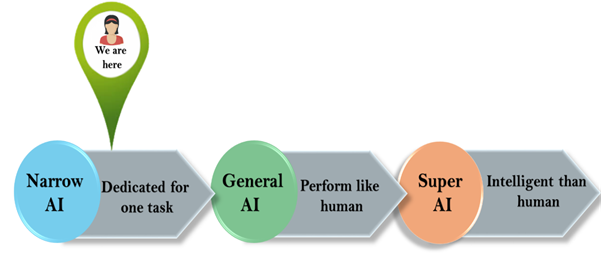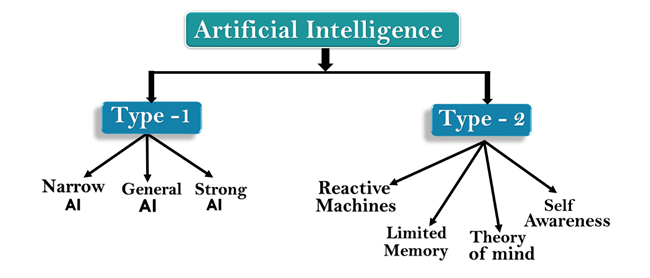Artificial Intelligence can be divided in various types, there are mainly two types of main categorization which are based on capabilities and based on functionally of AI.
Following is flow diagram which explain the types of AI.
AI type-1: Based on Capabilities
1. Weak AI or Narrow AI:
- Narrow AI is a type of AI which is able to perform a dedicated task with intelligence. The most common and currently available AI is Narrow AI in the world of Artificial Intelligence.
- Narrow AI cannot perform beyond its field or limitations, as it is only trained for one specific task. Hence it is also termed as weak AI. Narrow AI can fail in unpredictable ways if it goes beyond its limits.
- Apple Sirias a good example of Narrow AI, but it operates with a limited pre-defined range of functions.
- IBM's Watson supercomputer also comes under Narrow AI, as it uses an Expert system approach combined with Machine learning and natural language processing.
- Some Examples of Narrow AI are playing chess, purchasing suggestions on e-commerce site, self-driving cars, speech recognition, and image recognition.
2. General AI:
- General AI is a type of intelligence which could perform any intellectual task with efficiency like a human.
- The idea behind the general AI to make such a system which could be smarter and think like a human by its own.
- Currently, there is no such system exist which could come under general AI and can perform any task as perfect as a human.
- The worldwide researchers are now focused on developing machines with General AI.
- As systems with general AI are still under research, and it will take lots of efforts and time to develop such systems.
3. Super AI:
- Super AI is a level of Intelligence of Systems at which machines could surpass human intelligence, and can perform any task better than human with cognitive properties. It is an outcome of general AI.
- Some key characteristics of strong AI include capability include the ability to think, to reason, solve the puzzle, make judgments, plan, learn, and communicate by its own.
- Super AI is still a hypothetical concept of Artificial Intelligence. Development of such systems in real is still world changing task.

Artificial Intelligence type-2: Based on functionality
1. Reactive Machines
- Purely reactive machines are the most basic types of Artificial Intelligence.
- Such AI systems do not store memories or past experiences for future actions.
- These machines only focus on current scenarios and react on it as per possible best action.
- IBM's Deep Blue system is an example of reactive machines.
- Google's AlphaGo is also an example of reactive machines.
- IBM’s Deep Blue that defeated chess grandmaster Garry Kasparov is a reactive machine that sees the chessboard pieces and reacts to them.
- Deep Blue cannot refer to any of its prior experiences or improve with practice.
- It can identify the pieces on a chessboard and know how each moves. Deep Blue can make predictions about what moves might be next for it and its opponent.
- It ignores everything before the present moment and looks at the chessboard pieces as it stands right now and chooses from possible next moves.
2. Limited Memory
- Limited memory machines can store past experiences or some data for a short period of time.
- These machines can use stored data for a limited time period only.
- Self-driving cars are one of the best examples of Limited Memory systems. These cars can store recent speed of nearby cars, the distance of other cars, speed limit, and other information to navigate the road.
- Limited Memory AI observes how other vehicles are moving around them, at present, and as time passes.
- This ongoing, collected data gets added to the AI machine's static data, such as lane markers and traffic lights.
- They are included when the vehicle decides when to change lanes, avoid cutting off another driver, or hit a nearby vehicle.
3. Theory of Mind
- Theory of Mind AI should understand the human emotions, people, beliefs, and be able to interact socially like humans.
- This type of AI machines are still not developed, but researchers are making lots of efforts and improvement for developing such AI machines.
- One real-world example of the theory of mind AI is Kismet. Kismet is a robot head made in the late 90s by a Massachusetts Institute of Technology researcher. Kismet can mimic human emotions and recognize them.
- Both abilities are key advancements in theory of mind AI, but Kismet can’t follow gazes or convey attention to humans.
- Sophia from Hanson Robotics is another example where the theory of mind AI was implemented.
- Cameras present in Sophia's eyes, combined with computer algorithms, allow her to see. She can sustain eye contact, recognize individuals, and follow faces.
4. Self-Awareness
- Self-awareness AI is the future of Artificial Intelligence. These machines will be super intelligent, and will have their own consciousness, sentiments, and self-awareness.
- These machines will be smarter than human mind.
- Self-Awareness AI does not exist in reality still and it is a hypothetical concept.


This comment has been removed by the author.
ReplyDelete